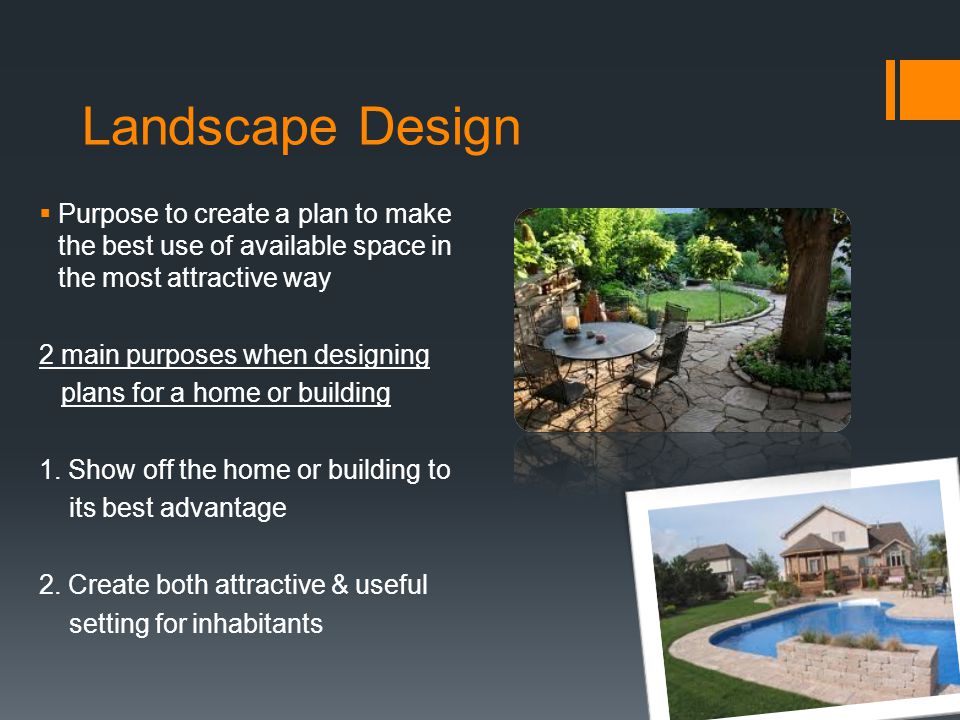The Ultimate Guide To Hilton Head Landscapes
The Ultimate Guide To Hilton Head Landscapes
Blog Article
6 Easy Facts About Hilton Head Landscapes Shown
Table of ContentsFacts About Hilton Head Landscapes UncoveredUnknown Facts About Hilton Head LandscapesThe Hilton Head Landscapes IdeasThe 25-Second Trick For Hilton Head LandscapesGet This Report on Hilton Head LandscapesHilton Head Landscapes Can Be Fun For EveryoneExcitement About Hilton Head Landscapes
Line develops all types and patterns and can be made use of in a variety of ways in the landscape. Line in the landscape is created by the edge in between 2 materials, the overview or shape of a type, or a long linear attribute. Lines are a powerful device for the developer due to the fact that they can be used to develop an unlimited selection of shapes and kinds, and they manage movement of the eye and the body.

Lines in the landscape. The residential properties of lines identify exactly how people respond to the landscape, both mentally and literally.
Not known Facts About Hilton Head Landscapes
Curved lines create a casual, natural, kicked back personality that is linked more with nature and asymmetrical balance. Curved lines move the eye at a slower pace and add mystery to the room by creating hidden views.
Vertical lines in the landscape consist of high, slim plant material, such as trees, or tall structures, such as an arbor or a bird home on a post. Straight lines move the eye along the ground plane and can make an area feel larger. Low lines are much more controlled and develop a feeling of rest or repose.
Fascination About Hilton Head Landscapes
Lines are likewise developed by the vertical kinds of built functions and plant material. There are three key line kinds that produce kind in the landscape: bedlines, hardscape lines, and plant lines.
Bedlines link plant product to the home and hardscape since the eye follows the line, moving the stare via the landscape. Hardscape lines are produced by the side of the hardscape, which marks the built framework. Line can likewise be developed by long and slim materials, such as a fence or wall surface.
Things about Hilton Head Landscapes
Form is discovered in both hardscape and plants, and it is generally the dominant visual component that spatially organizes the landscape and frequently determines the style of the garden. The type of structures, plant beds, and yard accessories also determines the total form motif of the garden. Official, geometric types consist of circles, squares, and polygons.
Plants develop form in the yard via their outlines or silhouettes, however type can likewise be specified by a gap or adverse room between plants - Landscaping bluffton sc (https://www.figma.com/design/CqNShAPJ75DpMEeGt0LfQR/Untitled?t=lZt5bM9P0avBSZvk-1). Circles can be full circles, or they can be divided into half circles or circle sectors and integrated with lines to produce arcs and tangents
Hilton Head Landscapes Things To Know Before You Get This
Circles can also be extended into ovals and ellipses for even more range and passion. Circles are a strong design form since the eye is always drawn to the facility, which can be utilized to stress a centerpiece or link various other types. Figure 2. Circular kinds in hardscape and yard panels.
The square form can likewise be fractional and previously owned repetitively to create a grid pattern. Unlike circles, squares are stronger on the brink, which can be lined up or overlapped to create one-of-a-kind patterns and more complicated forms. Polygons are many-sided types with straight sides. Triangulars, for instance, are three-sided polygons.
Twisting lines typically mimic the natural program of rivers or streams and can be called smooth lines with deeply curved undulations. Meandering lines (Number 3) function well for pathways, plant bedlines, and completely dry stream beds. Meandering lines can include rate of interest and enigma to a yard by leading viewers around corners to find brand-new sights and rooms.
Hilton Head Landscapes Fundamentals Explained

Usual plant types are well established and standardized, as form is the most regular and well-known feature of plants. Type can also be produced via the massing of plants, where the general mass produces a different kind than a specific plant.
A very contrasting kind must be used with careone or more work well as a focal point, but way too many produce mayhem. Natural plant forms, instead than over-trimmed forms, should develop the bulk of the make-up. The importance of overall kind is basically reliant on the viewing perspectivethe type of a tree can appear rather different to an individual standing under the canopy versus watching the tree from a range in an open area.
The Only Guide to Hilton Head Landscapes
Plant forms additionally develop and define the gap or open rooms between the plants, creating either convex or scooped kinds in deep spaces. High-arching tree branches typically produce a concave open area under the branches, and a rounded canopy with low branches fills the area to develop a convex kind outdoors space under the tree.

Report this page